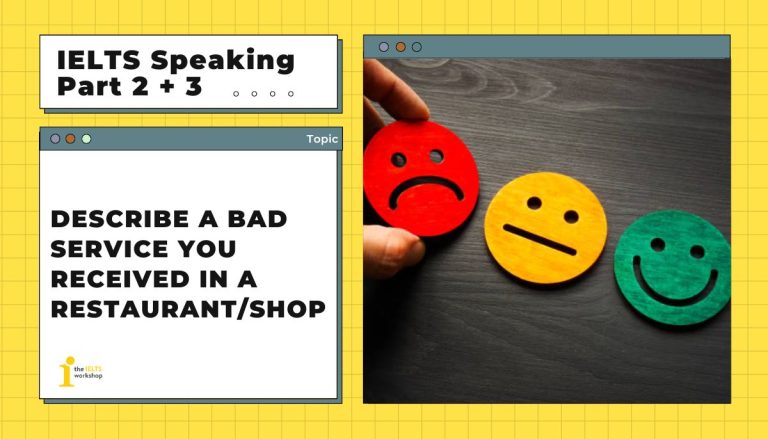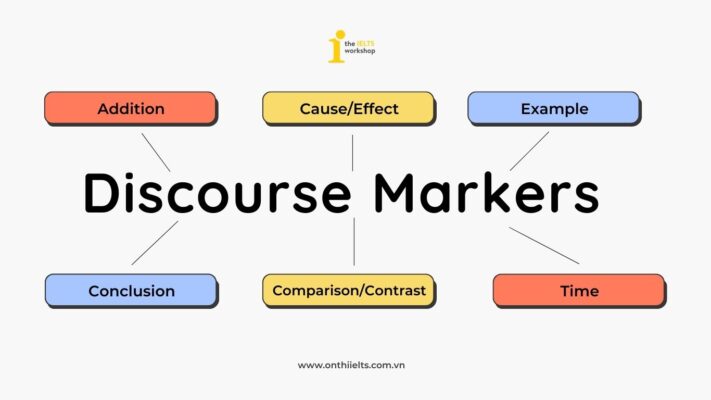Trong chuyên mục giải đề dưới đây, thầy Thanh Tùng của The IELTS Workshop HN sẽ hướng dẫn bạn trả lời topic “Describe a bad service you received in a restaurant/shop“ trong IELTS Speaking Part 2. Cùng tham khảo sample, từ vựng và một vài cách diễn đạt ghi điểm trong phần thi IELTS Speaking nhé.
Part 2: Describe a bad service you received in a restaurant/shop
Describe a bad service you received in a restaurant/shop
You should say:
When and where it happened
What happened
How you reacted
And explain how you felt about the experience
Dưới đây là bài mẫu cho topic “Describe a bad service you received in a restaurant/shop“.
1. Bài mẫu (Sample)

2. Từ vựng (Vocabuary)
- Discriminatory (Adj.): Phân biệt đối xử
- Demeanor (Noun): Thái độ, ứng xử
Part 3
How do most people respond to bad services?
Do you think services are better now than in the past?
What kind of services are bad services?
Why do some people choose to remain silent when they receive bad services?
Who should be responsible for bad services?
What can employers do to improve the service that their employees provide?
1. How do most people respond to bad services?
In Hanoi, people generally respond to bad services in diverse ways. While some individuals may choose to express their dissatisfaction immediately by providing feedback or complaining to the management, others may prefer to remain silent and simply avoid patronizing the establishment again. It’s not uncommon for people to share their negative experiences with friends and family, which can influence others’ choices.
- Diverse (Adj.): Đa dạng
- Patronizing (Verb): Làm khách hàng
2. Do you think services are better now than in the past?
Regarding the improvement in services over time, there is a mixed perception. Some argue that services have indeed become better due to increased competition and customer awareness. Others, however, believe that despite advancements, certain sectors still struggle to maintain consistent quality. For instance, the hospitality industry may have improved, but challenges persist in areas such as public transportation and healthcare.
- Perception (Noun): Nhận thức
3. What kind of services are bad services?
Bad services can take various forms, but commonly, they involve a lack of courtesy, responsiveness, or efficiency. In a restaurant, it could be slow service, rude staff, or unclean facilities. In other contexts, it might be unhelpful customer support, delayed deliveries, or poor product quality.
4. Why do some people choose to remain silent when they receive bad services?
People may choose to remain silent when they receive bad services for various reasons. Cultural factors might play a role, as some individuals may feel uncomfortable expressing dissatisfaction openly. Fear of confrontation or the belief that complaining won’t make a difference could also contribute to their silence. Additionally, some may not want to invest time and energy in pursuing a resolution, especially if the issue seems minor.
- Confrontation (Noun): Sự đối đầu
5. Who should be responsible for bad services?
Responsibility for bad services should be shared between the service providers and the management. Frontline staff must undergo proper training to handle diverse situations and maintain a customer-centric approach. Management should ensure a conducive work environment, encourage employee feedback, and address systemic issues promptly. Ultimately, both parties play vital roles in delivering satisfactory services.
- Conducive (Adj.): Thuận lợi
- Frontline (Adj.): Ở vị trí hàng đầu, đầu tiên
- Systemic (Adj.): Hệ thống, toàn bộ hệ thống
- Promptly (Adv.): Ngay lập tức
6. What can employers do to improve the service that their employees provide?
To improve the services provided by employees, employers can implement several strategies. First and foremost, comprehensive training programs should be established to enhance employees’ skills and customer service etiquette. Regular feedback mechanisms, both from customers and within the organization, can help identify areas for improvement. Recognizing and rewarding excellent service can also motivate employees to maintain high standards. Additionally, fostering a positive workplace culture that values customer satisfaction can contribute to overall service improvement.
Bài mẫu bởi thầy Thanh Tùng – Giáo viên The IELTS Workshop HN
Trên đây là bài mẫu cho topic: Describe a bad service you received in a restaurant/shop. Các bạn có thể tham khảo các bài mẫu IELTS Speaking khác của The IELTS Workshop tại đây!
Để có thể học và nắm được phương pháp xây dựng câu trả lời cho phần thi IELTS Speaking Part 3, tham khảo ngay Khóa bổ trợ từng kỹ năng IELTS chuyên sâu của The IELTS Workshop









